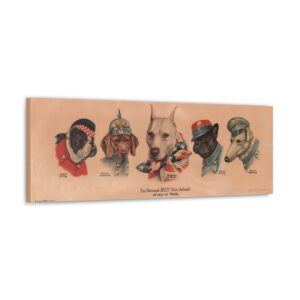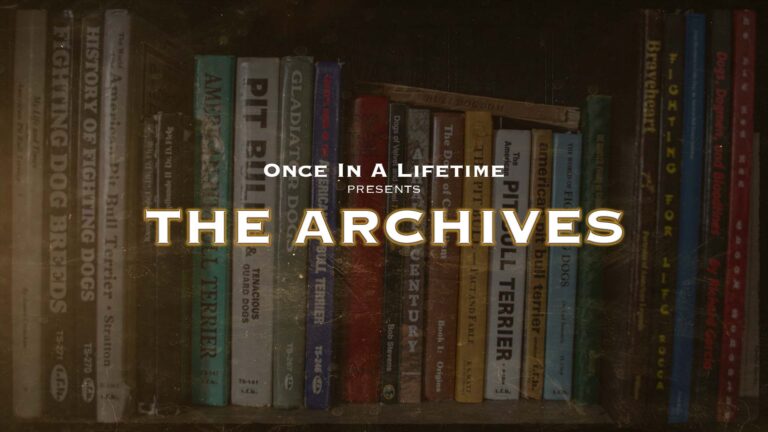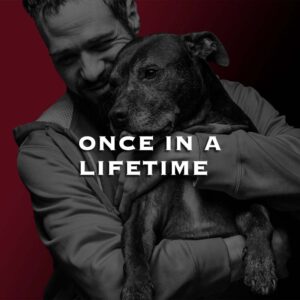Home » Films » Once In A Lifetime » The Archives » 1893 White Pit Bull with Children | The Archives
Another Pit Bull dog on a cabinet card
We’ve already seen one white pit bull dog on a cabinet card from the 1890s in this blog series – The Archives. In Archive #3 we have yet another! This time it’s a white pit bull with his children taken in 1893. Yes, that exact year.
I know this to be a verified fact because the clues given in this cabinet card photograph were enough to make those solid conclusions.
Pit Bulls photographed with children
When advancements in technology allowed us to capture moments in time, and photography studios then opened in the mid-1800s, it was not uncommon for dogs to be included in family portraits.
While I admit there are differences in how life was 170 years ago compared to now, researching these vintage artifacts made me realize there’s a lot that hasn’t changed as much as we think it has. And this relationship between human and canine is one of them.
Clearly people loved their pets and thought of them as members of their family. Otherwise they would not be entrusted with their young children and photographed in family portraits.
While dogs of all types were seen, it was in this era where you’d find a lot of early photographs of pit bull dogs and children. I assume this helped create an idea that pit bulls were the ‘nanny dog’.
Obviously, that moniker was never meant to be taken literally, but there are a fair share of available vintage photographs depicting this theme of pit bull dogs together with children.
Who were the pit bull dog and children in this photograph?
Unfortunately, the name of the white pit bull dog hasn’t yet been found. But, on the backside of the card there is a handwritten note that reads –
Nyle W. Vrooman taken January 19, 1983
It would be easy to stop the search there and assume that one of these two kids has to be Nyle. But, since most of these images are well over a century old, and one of the purposes of this blog series is to bring them back to life, it wouldn’t be right to quit so quickly.
Additional searches didn’t come up with much. A couple articles in the local Watervliet newspaper from the 1920s where Nyle was briefly named along with mentioning his wife and kids.
A listing on the website – Ancestry, which helps track family history, came up for Mr. Vrooman. According to the U.S. Census in 1940, Nyle was 47 years old. And, that would have made him born in 1893 – when the photograph was taken.
So, it’s quite possible the younger child sitting in the wagon is Nyle W. Vrooman…with his pit bull dog.
About the Photographer
Printed on the front of these cabinet card is almost always the studio name, and sometimes the location where the photographer worked out of.
This is always priceless information, because if the business was real, there’s likely some record somewhere about it. In this case, Austin’s Studio operation in Watervliet, Michigan. But, who is the actual person behind the scenes taking the photographs?
I did some more digging and I believe his full name was George W. Austin.
I found a PDF from the University of Michigan, who put together a directory of early Michigan photographers. In this document, I narrowed down my search by limiting only the names of photographers who were based out of this Watervliet town. And, again to only photographers who were active in the late 1800s.
If true, George W. Austin was born in July 1862. He worked on his father’s farm, then married a woman named Mary in 1886 – with whom he had a daughter named Marnie.
Included in the final sentence of this bio, they wrote:
“Following a long illness, George died on April 1, 1923. His daughter had been active in the business for several years, and Austin Studio continued in Kalamazoo under Marnie’s management for another decade.”
About Cabinet Card Photography
This is the second cabinet card we’ve seen in this series, and trust me, we will be seeing many more examples of them in future entries.
The Cabinet Card was first developed in the 1860s, and grew in popularity in the 1880s. Essentially, it’s a photograph mounted on a stiff cardboard, and intended on being displayed in a sitting room, rather than placed in an album.
While still used until the 1920s, it’s use declined at the turn of the century once personal photography became more the norm. A great summary of how to spot a cabinet card is found in this Science and Media Museum blog post – How to spot a Cabinet Card.
About "the Archives"
The Archives is a special blog series that looks at the complicated history of pit bull dogs through photographs, newspaper articles, and other historical items. This blog is part of the documentary film – Once In A Lifetime.
Purchase a piece of history to hang in your home or your office:
-

“I’m Neutral, But Not Afraid Of Any Of Them” | 36 x 12 Canvas
$64.00 Select options This product has multiple variants. The options may be chosen on the product page



